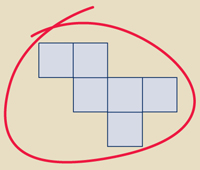| The
assessments included 15 tasks investigating students’ understandings,
processes and skills in the area of geometry. Geometry is concerned
with geometrical relations in two and three dimensions, and their
occurrence in the environment. It also involves recognition of
the geometrical properties of everyday objects and the use of
geometric models as aids to solving problems.
Eleven of the tasks were identical for both year 4 and year 8.
Four of the tasks were given to year 8 only. Five of the tasks
are trend tasks (fully described with data for both 2001 and 2005),
three are released tasks (fully described with data for 2005 only)
and seven are link tasks (to be used again in 2009, so only partially
described here).
The tasks are presented in three sections: trend tasks, then released
tasks and finally link tasks. Within each section, tasks attempted
by both year 4 and year 8 students are presented first, followed
by tasks attempted only by year 4 students and then tasks attempted
only by year 8 students.
There were 31 task components administered to both year 4 and
year 8 students. In each of these, the year 8 students showed
a higher success rate than the year 4 students. On average, year
8 students out-performed year 4 students by 20.6%. Differences
between year 4 and year 8 students were fairly consistent across
the tasks.
There were 16 task components in common for 2001 and 2005 for
year 4. Eight of those tasks showed a gain over the four-year
period, and the other eight showed a decline. The net difference
over the 16 tasks was a decrease of slightly less than one percent.
There were 19 task components in common for 2001 and 2005 for
year 8. Eleven of those tasks showed a gain over the four years
and eight showed a decline, with a net increase of slightly less
than one percent. The largest declines came in the area of finding
symmetry in a pattern (see Köwhaiwhai
Pattern, p45), and the largest gains came in the area
of drawing geometric figures (see Dot
to Dot, p46).
In the new tasks that were released for this year, year 8 students
showed some level of difficulty in using protractors to measure
angles and in representing mental rotations of two dimensional
objects. |
 |

|